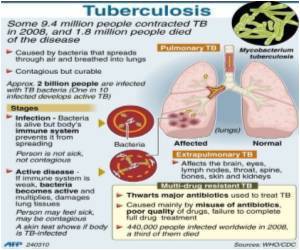More than nine out of ten cases of tuberculosis, which kills 1.8 million people each year, could be averted by 2050 with better testing, drugs and vaccines, according to a major review

But TB remains a deadly scourge that fails to attract as many health dollars, euros and yen as other diseases claiming as many or fewer victims, the journal said.
"Tuberculosis is unfashionable these days," said Lesotho Health Minister Mphu Ramatlapeng at a press conference in Geneva, where the report was unveiled at the World Health Organisation (WHO).
Some 36 million people infected with TB during 1995-2008 were cured and incidence of the lung-wasting disease has begun to regress, but only by about one percent per year.
The most urgent -- and most easily remedied -- problem is poor diagnosis, the report said.
More than 80 percent of all TB cases occur in only 22 countries, including nine in Africa, 11 in Asia, and Russia.
Advertisement
Advertisement
Up to two-thirds of cases in South Africa and Zimbabwe, for example, are thought to be caused by HIV co-infection.
Frequent testing for HIV and the early start of antiretroviral treatment (ART) would help cut incidence by reducing the number of people with compromised immune systems, it said.
Another looming threat are so-called "multidrug-resistant" (MDR) forms of TB.
Most types of tuberculosis can be cured with ten euros (13 dollars) worth of medicine if diagnosed early.
But when patients fail to complete a treatment, the Mycobacterium tuberculosis germ that causes the disease develops a resistance to frontline drugs such as isoniazid and rifampicin.
Treating the new superbugs costs thousands of dollars (euros) and can take up to two years, and even then may fail.
"Without significant investment in technology and capacity for prevention, diagnosis and treatment, MDR-TB threatens to become the dominant strain of TB over the next few decades," the study warns.
"The future possibility of strains that are totally resistant to all anti-tuberculosis drugs is not inconceivable."
In 2008, some 440,000 cases of MDR-TB occurred worldwide, half of them in China and India. Only seven percent, however, of these infections were treated.
Turning back the tide on TB will require boosting basic health care infrastructure and targeted prevention measures, including improved vaccines, better use of antibiotics and reduction of risk factors.
There remains a "desperate need" for a more accurate, cheaper test for detection, and for so-called "biomarkers" that predict whether an individual is more likely to be cured by treatment or to relapse, and whether vaccines will work.
All of this takes money, which has fallen far short of needs: the funding gap in high-burden countries -- measured against the Global Plan to Stop TB -- is some half-a-billion dollars in 2010, the study reports.
"Tuberculosis can no longer be the neglected sister of HIV and malaria," the authors say, pointing out that the US National Institutes of Health (NIH) spend about seven percent as much on TB research as for HIV, even though both diseases kill roughly the same number of people worldwide.
Source-AFP
SRM









